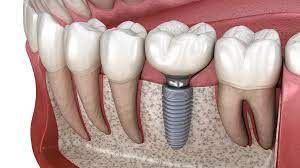Dental implants are a highly effective solution for replacing missing or damaged teeth. Whether you’re considering implants due to tooth loss from injury, decay, or age, understanding what to expect during the procedure can help reduce anxiety and ensure you’re fully prepared. While the procedure itself can vary depending on individual needs, it generally follows a predictable process. In this step-by-step guide, we’ll walk you through what to expect during your dental implant procedure and how it compares to other options, such as affordable dentures locations, which may be an alternative for some patients.
Step 1: Initial Consultation and Evaluation
Before undergoing any dental implant procedure, you’ll first have a thorough consultation with your dentist or oral surgeon. During this initial visit, your dentist will evaluate your oral health and determine whether dental implants are a suitable option for you.
- X-rays and 3D Imaging: Your dentist will take detailed X-rays or 3D images of your mouth to assess the condition of your jawbone, the alignment of your teeth, and the surrounding tissue. This helps ensure there’s enough bone to support the implant.
- Medical History Review: The dentist will also discuss your medical history, current medications, and any pre-existing conditions, as these could influence the procedure.
- Treatment Plan Discussion: Based on the evaluation, your dentist will create a personalized treatment plan, outlining the type of implants you need, the number of implants to be placed, and the timeline for the procedure.
If you’re considering affordable dentures locations as an alternative, your dentist will likely also discuss the pros and cons of dentures compared to implants, helping you make an informed decision based on your budget, lifestyle, and long-term goals.
Step 2: Preparation for Surgery
Once you and your dentist decide to move forward with dental implants, the next step is preparing for surgery. The preparation will vary depending on the complexity of the procedure and whether any additional steps are necessary, such as bone grafting.
- Sedation Options: Most patients undergo the procedure under local anesthesia, ensuring that the surgical area is numb. For those who are anxious or prefer to be more relaxed, sedation options like oral sedatives or IV sedation may be offered.
- Pre-Surgery Instructions: Your dentist will provide specific instructions before the surgery, such as fasting for several hours if you are receiving sedation.
For patients who have visited affordable dentures locations to explore other options, understanding the differences between these options and dental implants will be important. Dentures are removable and do not require surgery, but they do not prevent bone loss like implants do.
Step 3: Implant Placement Surgery
The core of the dental implant procedure is the placement of the titanium implant into the jawbone. This is a minor surgical procedure, usually completed in one visit, although multiple sessions may be required for more complex cases.
- Making an Incision: The dentist will make a small incision in your gum to expose the bone.
- Placing the Implant: The titanium implant post is then carefully placed into the jawbone. If you’re receiving a full set of implants, the procedure might involve multiple posts being placed in a single visit. For patients who are also opting for affordable dentures locations, this might be an important consideration, as dentures don’t require such invasive steps.
- Suturing the Gum: After the implant post is securely placed, the gum is sutured closed. In some cases, temporary crowns or bridges may be placed to help protect the area and provide you with a functional tooth while healing takes place.
During the healing period, your bone will fuse with the implant in a process known as osseointegration. This can take several months to fully complete, ensuring that the implant is firmly anchored into your jaw.
Step 4: Healing and Osseointegration
One of the most important steps in the dental implant procedure is the healing process. The jawbone must fully integrate with the titanium implant before the next step can be completed. This typically takes anywhere from 3 to 6 months, depending on individual healing rates.
- Follow-Up Appointments: You’ll need to attend follow-up appointments with your dentist during this time to ensure that the implant is healing properly. The dentist will check for any signs of infection, discomfort, or complications.
- Bone Grafting (if necessary): In some cases, if there wasn’t enough bone to support the implant initially, bone grafting may be required. This step adds additional healing time, but it’s an important part of ensuring the long-term success of the implants.
Step 5: Placing the Abutment and Permanent Crown
Once the implant has fully integrated with the jawbone, the next step is to place the abutment (a small connector piece) and the permanent crown or prosthetic tooth.
- Abutment Placement: The abutment is attached to the implant post, and the gum tissue around the implant is adjusted to fit securely.
- Custom Crown or Bridge: A custom-made crown, bridge, or set of teeth will be designed to match the shape, size, and color of your natural teeth. This ensures that the implant looks and functions just like a natural tooth.
At this point, the implant will be fully functional, and you can expect to enjoy a fully restored smile.
Step 6: Aftercare and Maintenance
After the procedure, your dentist will provide aftercare instructions to ensure a smooth recovery. These may include recommendations for pain management, diet, and hygiene.
- Pain Management: It’s normal to experience some discomfort after the procedure. Over-the-counter pain relievers or prescription medications may be recommended to manage this.
- Oral Hygiene: Maintaining proper oral hygiene is critical to the long-term success of your dental implants. Your dentist will show you how to care for your implants, including brushing and flossing techniques.
If you’ve been exploring affordable dentures locations, you might find that dentures require different maintenance habits, including soaking and occasional relining. In contrast, implants require care similar to that of natural teeth, and they do not need to be removed for cleaning.
Conclusion
The dental implant procedure is an effective, long-lasting solution for those who are missing teeth. Though the process can take several months to complete, the result is a beautiful, functional smile that looks and feels like natural teeth. Whether you’re opting for dental implants or considering alternatives such as affordable dentures locations, it’s important to consult with your dentist to determine the best solution for your needs. By understanding the steps involved in the dental implant process, you can make an informed decision that will benefit your oral health and confidence for years to come.
Read More ( Click Here )






